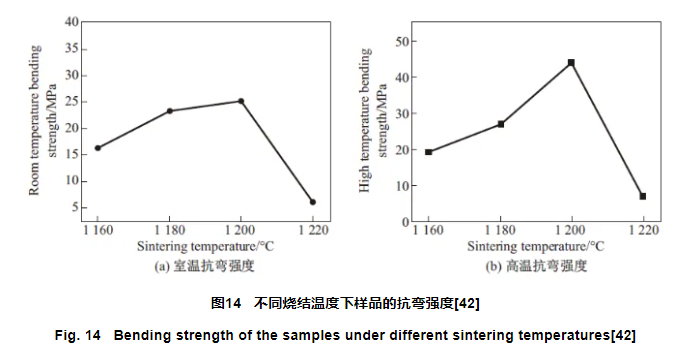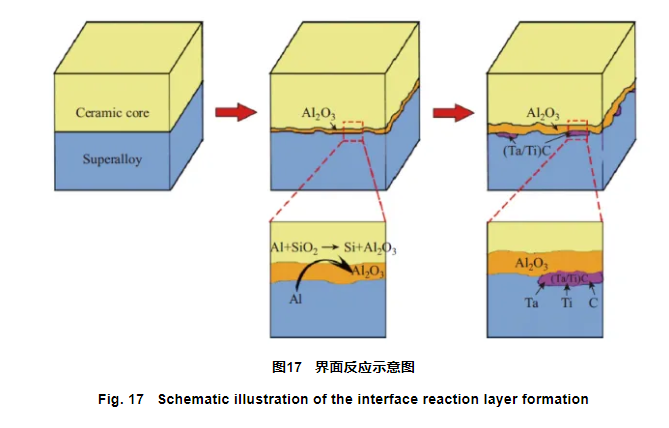The function of the ceramic core is to form a cooling channel inside the blade, so its performance and quality directly affect the quality of the hollow blade. Ceramic core should meet the following requirements: 1. good chemical stability and thermal stability; 2. The linear expansion coefficient is small to ensure low deformation during the pouring process; 3. Suitable porosity, easy to be removed from the casting [38⇓-40]. At present, the developed countries will be the ceramic core development technology as a highly confidential not open, the international market has been monopolized by foreign companies. We have made some achievements in the research of ceramic core.
1 .Silicon based ceramic core
Silica based ceramic core with quartz glass as the main material, the most widely used [41]. The firing temperature of silicon oxide based ceramic core is usually 1 100 ~ 1 250∘∘C, and the service temperature is about 1 550∘∘C. We studied the effects of particle size of matrix powder, sintering process and additives on the comprehensive properties of silicon-based ceramic cores, explored the effects of sintering temperature and particle size distribution on the properties of porous silica ceramic cores, and grasped the changing laws of the strength of ceramic cores at room temperature and high temperature under different sintering temperatures. As can be seen from the figure, when the sintering temperature is 1 200∘∘C, the comprehensive performance of silicon oxide ceramic core is the best. The effect of particle size distribution on the porosity of ceramic core is one of the main reasons for the change of ceramic core performance, and the uniform distribution of powder core has the best comprehensive performance. Based on this, a method of infiltrating silicone resin into silica-based ceramic core under vacuum condition is proposed to improve its mechanical properties.

2. Influence of mineralizer on ceramic core performance
2.1 Single mineralizer
- The mineralizer interacts with the matrix material to activate the lattice and then form a solid solution, or at the sintering temperature, the mineralizer transforms into the liquid phase bonding matrix material, or prevents the polycrystalline transformation of the matrix material [44]. The mineralizer plays a decisive role in sintering shrinkage, deformation and mechanical properties of the core. At present, the focus of ceramic core research is to reduce the size shrinkage and deformation of the core during sintering and improve its mechanical properties. The effects of different mineralizers on the properties of silicon-based ceramic cores were systematically studied. When zirconium silicate is used as mineralizer, it has no obvious effect on the crystallization of ceramic core, but it can reduce the viscous flow of quartz glass and the sintering degree of core. The higher the amount of zirconium silicate, the lower the shrinkage rate and room temperature strength of the sample, and the higher the apparent porosity.
- At the same time, zirconium silicate can play a role in strengthening the matrix skeleton, which can improve the high temperature strength of the core. When fused mullite is used as mineralizer, the bending strength at room temperature, bending strength at high temperature and deflection at high temperature of ceramic core can be decreased, and the shrinkage rate of ceramic core can be decreased and the porosity can be increased. In addition, we also explored the influence of cut quartz fiber on the comprehensive properties of silicon-based ceramic cores. Through SEM fracture analysis of samples with different fiber additions, the results are shown in FIG. 15. It can be seen that the quartz fiber interspersed in the matrix shows excellent high temperature stability, and does not sintered with the matrix particles, and retains certain pores around it. The addition of quartz fiber can increase the precipitation amount and porosity of cristobalite. With the increase of quartz fiber content, the shrinkage rate and high temperature deflection of the ceramic core of cristobalite gradually decrease. When 0.5% quartz fiber is added to the ceramic core, its comprehensive performance is greatly improved.


2.2 Compound mineralizer
In addition to the addition of a single mineralizer, in order to explore the effects of synergies between multiple mineralizers on the performance of silica-based ceramic cores, we prepared composite silica-based ceramic cores by adding zirconium silicate-mullite fiber. The effects of mullite fiber on the mechanical properties and high temperature properties of ceramic cores were studied. The results show that with the increase of mullite fiber content, the linear shrinkage of ceramic core decreases obviously, and the porosity increases gradually. When the mass fraction of mullite fiber is 1%, the bending strength of ceramic core at room temperature and simulated pouring temperature is significantly improved compared with that of ceramic core with only zirconium silicate as mineralizer. This is because the fibers are discontinuously distributed in the ceramic matrix and play the role of connecting the bridge, blocking the crack propagation path, and thus improving the bending strength of the ceramic core.


3.Interface reaction between ceramic core and superalloy
For the turbine blades of advanced heavy-duty gas turbines, the increase of superalloy melting point and blade size leads to high pouring temperature and long solidification time during the preparation of single crystal blades [49], which makes the reaction tendency at the interface of superalloy/ceramic core/shell more prominent, and seriously affects the performance of superalloy blades. In order to further understand this problem, we studied the interfacial reaction of nickel base single crystal superalloy CMSX-4 during directional solidification with silicon oxide ceramic core. The results show that a continuous alumina layer and a discontinuous enriched carbide layer are formed at the interface of the superalloy/silicon oxide ceramic core. On this basis, we analyzed the formation mechanism of the interfacial reaction between nickel-based single crystal superalloy and silicon oxide ceramic core (see Figure 17), which provides a basis for optimizing the composition and properties of ceramic core.


Contact us
If you are interested in collaborating with us on ceramic core research, we would be delighted to hear from you. We believe that through joint efforts, we can further enhance the technology and application of ceramic cores. Whether it’s for sharing research findings, conducting joint experiments, or exploring new applications, we are open to various forms of cooperation.
